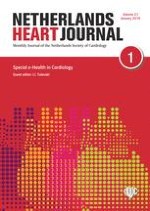01-11-2007 | Case report
Transvenous pacing after the Mustard procedure: considering the complications
Gepubliceerd in: Netherlands Heart Journal | Uitgave 11/2007
Log in om toegang te krijgenAbstract
Disturbances of rhythm and conduction in patients undergoing surgery for transposition of the great arteries have been widely reported. Some of these patients require implantation of a permanent pacemaker, especially those in whom symptomatic sick sinus syndrome is diagnosed. We present the case of a 29-year-old male corrected with a Mustard procedure, who received a pacemaker for progressive atrioventricular conduction disturbances and sinus node dysfunction, and we review the possible complications associated with transvenous pacemaker implantation in these patients. (Neth Heart J 2007;15:387-389.)
